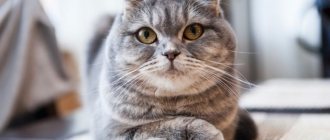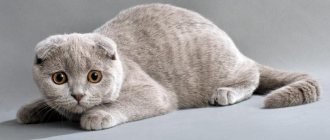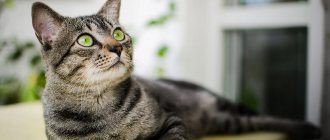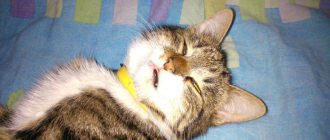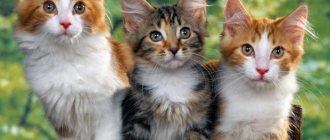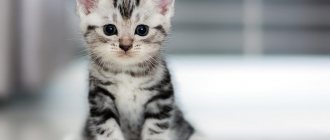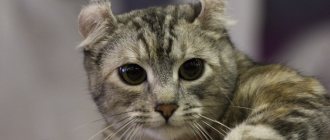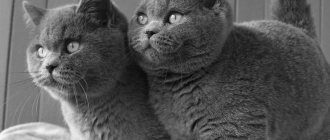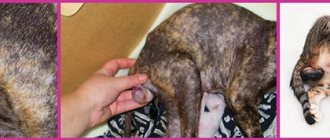Among all the breeds of the cat family, those cute fluffy animals have always stood out that were the favorites of the aristocratic houses of Europe, both in the Middle Ages and in Modern Times. For example, the white British cat has always enjoyed special love among ladies from the upper classes, almost all royal houses of the past.
Among the many breeds, the British White is one of the most famous of the domesticated felines that has been around since time immemorial. According to zoologists, in our time more than two hundred variants of coat colors of these animals have been registered.
History of the origin of the breed
According to most employees of historical archives, archaeologists and researchers, the white British cat is one of the oldest breeds of domesticated cats.
According to legend, the British Shorthair cat appeared in the British Isles along with the army of conquerors from the Roman Empire. Artistic depictions of those years show animals whose distinctive features are gray coats and sharp fangs.
There is a second version of the appearance of cats in Great Britain. The animals were brought to the islands by French sailors, who used them to fight rats in the holds of ships.
Maintenance and care
The British Fold does not require special attention, since he gets used to looking after himself from an early age, repeating the movements of his mother. But still its content implies:
- regular feeding with either dry food or natural products, and always a full drinking bowl;
- cleansing the ears of wax, dirt and other accumulations, at least once every 2 weeks, using a special liquid and cotton swabs;
- combing the undercoat with special brushes at least once a week, and for a long-haired pet - at least three times, possibly against the grain;
- daily removal of dark discharge from the corners of the eyes with a napkin soaked in boiled water;
- cutting the claws every 3 weeks by 2-3 millimeters with a nail clipper and scratching post, examining them against the light to avoid getting on the vessel (only for cats that do not go outside);
- examination of the ears for rashes and eyes for purulent discharge, in which case you should visit a veterinarian;
- bathing no more than once every six months if there is an urgent need for warm water, the temperature of which does not exceed +40 degrees.
In addition, from an early age it is important to allocate personal space for the kitten, arrange a toilet and a place to sleep, and install a claw sharpener. Then he will quickly get used to the new housing and owners.
Proper care includes a balanced diet, 2-3 times a day in small portions.
A mixed diet is not recommended for this breed, that is, you should give the cat either ready-made food or natural products:
- lean meats - raw beef or turkey, boiled chicken, boneless and skinless fish;
- milk, fermented milk products and cottage cheese, less often you can pamper your pet with cream or sour cream, but not more than 2 times a month;
- oats, millet, rice can be cooked in broth with the addition of meat;
- cabbage, cucumbers, carrots and zucchini will fill the body with vitamins.
Description
It was the impeccable white color of the fur that gave the cats their original name – British White. The fur that covers the entire body of these aristocratic animals has a uniform color throughout the body, from the tip of the paws to the cute ears.
In adult British cats, the coat color does not have any additional spots of shade. There are several types of British cats that have solid colors.
Fold white
This breed of cat belongs to the Scottish White Fold, which are direct relatives of the British. Unknowing people believe that this is just a variety of the same breed, but Scottish cats exist as a separate species.
Rare color options
Breeders of the breed recognize the British color-point colors as the rarest, as well as two-color, tri-color and smoky.
Material on the topic: what is the British cat breed.
Two-color and three-color
White is acceptable in these color combinations. The earliest tortie and white tricolors were bred; the original version had black, red and white, but now any two colors are allowed in combination with white. Two-color cats saw the world a little later; their coat has spots of the same color on a white background. In the video below you can see the different colors and character traits of the British.
Color point
These cats originated almost four decades ago when breeders crossed Himalayan cats with British Shorthairs. This gave the breed a blue-eyed version of the British with a light coat that features contrasting mask-like markings on the face and darker coats on the ears, tail and paws. The transition of colors should be clearly defined and have a good contrast with the body. The breed standard also allows tortoiseshell-colored “glasses.”
Color Point can have light fawn, lilac or blue markings. If they are blue, then the pedigree will say: blue point. The muzzle should have a white marking in the shape of an inverted V. The top of the V should start at the forehead and widen to cover the nose and whisker pads. Markings should be as symmetrical as possible. There should be a good, clear contrast between the body color and the spots. The chest, chest and belly should be white; The cat's four paws should be white.
Material on the topic: everything about the British cat and caring for it.
Smoky
The smoky variety is characterized by a silver-colored undercoat, which is visible through the top layer of fur, especially when the cat moves, thereby creating a hazy effect. The top layer can be brown, tortoiseshell, or black.
Interesting Facts
Each cat breed has its own characteristics and its own history of origin and development. And the British were no exception to the rule. There are a number of interesting facts associated with them that are worth learning more about:
- British cats have an exceptional hearing system, due to the special structure of the eyeballs, which contain nerve endings that transmit environmental sounds to the ears.
- Britons have an excellent sense of smell, which should be more than 14 times stronger than that of other cats. After all, not only the main organ of smell perception, the nose, is responsible for the sense of smell, but also the antennae.
- White British cats do not have eyelashes. But this did not in any way affect their acute vision during evolutionary development.
- To fully restore their strength, the British have to sleep 14-16 hours a day.
- If you take proper care of your pet, white British cats can live more than 20 years.
British white
White cat breeds have always been particularly popular. How can you resist such a beautiful snow-white fur coat and piercing eyes? This is impossible. The white color of cats of other breeds is also very popular among cat lovers. At the same time, the British white is one of the most beloved.
It is worth considering that all cats, which we call white, have different shades of coat color.
. But the British White differs only in its snow-white coat, on which there is not a single dark or red hair. Thus, all British cats have uniform coat color throughout the body, with no lighter spots on the belly or at the base of the tail. Naturally, the British White is no exception to this. The short coat of a white British cat cannot have any reddish or cream spots that would spoil the appearance of the show animal.
So, the breed standards state that a white British dog cannot have any spots on its coat.
. Small spots on the animal's forehead can only be observed in kittens. These spots will disappear over time, leaving behind a snow-white coat. By the way, the color of the spots on a kitten’s forehead can tell you what color cat was used to produce offspring.
If you are going to breed your cat to produce offspring, remember one main rule: both animals must not be white
. For mating, a cat of a different color must be used. If both animals are white, then their offspring will be deaf.
White British cats are also distinguished by their eyes. Outbred white cats have green eyes. All British cats have orange or copper eyes.
. But the white British cat can also boast of having blue eyes. Blue-eyed white British cats are very rare, as they are not used in breeding. It is believed that white cats with blue eyes are deaf from birth. This does not mean that the cat will not hear you at all. The animal can catch certain sounds, but the cat will not hear the squeak of kittens calling for their mother.
All British White kittens are born with blue-gray eyes. After two weeks, eye color begins to change. By the intensity of the coloring pigment, already at this age, experienced breeders can tell whether a kitten will have blue or yellow eyes
. Due to the rules of mating cats, white kittens with blue eyes are very rare, but they are in very high demand.
There are also white British cats with different colored eyes.
. One eye is orange or copper in color, the other is blue. Such cats are also very rare. And among cat lovers there is an opinion that a cat with different eyes brings happiness and good luck to the house.
The British White cat's coat is very easy to care for.
. It is enough to comb the animal to remove all loose hairs, although the cat itself will take good care of its fur. If you are going to take part in exhibitions, then caring for your cat's fur should be more thorough. A week before the exhibition, the cat should be purchased. When the wool is completely dry, it should be powdered with baby powder. Then thoroughly comb the animal with a brush. Before the exhibition itself, any traces of powder should be removed from the fur, so the animal’s fur is rubbed with a silk scarf.
The British White is distinguished by its undemanding character. This is a calm, very affectionate and friendly animal. True, the British White is very picky when it comes to food. The diet must include meat (raw and scalded), which is cut into cubes. Thanks to this form of food pieces, the muscles of the cheekbones develop, from where the round cheeks characteristic of all British cats appear.
Related publications:
How much does it cost and where to buy
White British kittens are not such a shortage in the modern world. You can buy them in specialized nurseries. The price depends on the presence of a number of characteristics, in particular on color and class.
- The most expensive kittens are considered to be the elite Show class, costing from 40 thousand rubles.
- Breed class kittens are very popular among those who are going to breed them; the average price of a kitten is 22 thousand rubles.
- The cheapest pets are considered to be Pet class cats, which have a number of disadvantages and do not meet all breed standards. These kittens are sold at a price of 6 thousand rubles.
A white British shorthair cat without a pedigree can be purchased even cheaper, for 3-5 thousand rubles.
Feeding rules
The British are not particularly picky when choosing food, so feeding should not be a problem. But due to their massive size, they require a larger dose than a regular pet. But due to the fact that this breed has a tendency to obesity, they need to be fed on time and in doses.
In order for a cat to be healthy and active, you need to properly prepare a daily diet; it must be complete and balanced.
When choosing ready-made food, you should give preference to well-known premium varieties; they have a large number of advantages:
- the menu is balanced;
- contains vitamins and mineral complexes;
- it is possible to calculate the serving size based on the weight of the animal;
- Suitable for castrated and sterilized pets.
You can organize feeding with natural products, but in this case you should adhere to some rules:
- boiled or boiled meat and offal (except pork and lamb), large parts must be cut into small pieces, otherwise the cat may choke;
- various porridges, oatmeal and rice are more healthy, but it is allowed to add vegetable oils to them;
- boiled vegetables, except potatoes, as they contain starch;
- sea fish, but add it to the diet no more than once a week, since such a product can cause urolithiasis;
- low-fat fermented milk products.
If feeding is carried out exclusively with natural products, then it is necessary to additionally feed the animal with vitamins and minerals, it is especially important to do this during the growth period. In addition, it is necessary to provide your pet with clean drinking water; it should always be openly available and in the required quantity.
Health, reproduction, kittens
British Folds were created through crossbreeding, so they can be quite sickly.
In particular, they have a high risk of developing the following pathologies:
- Deformation of cartilage in some individuals affects not only the shape of the ears, but also the entire spine. Therefore, they may experience fusion of the vertebrae, shortening of bones and thickening of joints, and the appearance of bone growths, which can only be corrected surgically.
- Hypertrophic cardiomyopathy (HCM) is a genetically determined uneven thickening of the interventricular septum and ventricular walls. Progresses to heart failure with chest pain. The disease makes itself felt in individuals after a year and is detected by ultrasound.
- Obesity. Due to a good appetite, if you do not monitor your pet’s nutrition and activity, it can gain excess weight quite quickly. This in turn will lead to many health problems. A proper diet, outdoor games and plenty of space in the house or yard increases his activity and reduces the risk of illness.
- Worms, fleas and other parasites come from the outside, are absorbed with food or hairballs when licking, especially if the cat is in contact with other animals. Now there are many means to get rid of them, which are best used as prescribed by a veterinarian.
- Infectious diseases. These are immunodeficiency, aspergillosis with chronic runny nose, calcivirosis and rhinotracheitis. And especially life-threatening peritonitis, panleukopenia, leukemia, rabies, tuberculosis. To prevent them, vaccinations are necessary: annual against rabies starting from the age of 8 months, and others no later than the three-year period when maternal immunity is still in effect.
On average, adults live from 14 to 20 years if you monitor their condition.
For example, periodically lifting an animal by its front legs reduces the likelihood of developing spinal pathologies. Timely and proper care will avoid many other problems.
Particular attention should be paid to the issue of breeding pets. If owners want to get healthy offspring, under no circumstances should individuals with the same gene be crossed when both of them have drooping ears.
It is worth taking individuals with straight and curved ears, it is better if both of them belong to the British breed. And after 9 weeks it will be possible to get a mixed litter, but the likelihood of their mutation is significantly reduced.
The peculiarity of lop-eared cats is that they are all born with erect ears. They acquire their shape only on the 21st day, then it will be clear which of the babies will be straight-eared and which will be a typical representative of the British breed.
The owners will only have to choose suitable nicknames, remembering that the British are proud and independent animals, and they will serve their family faithfully.
